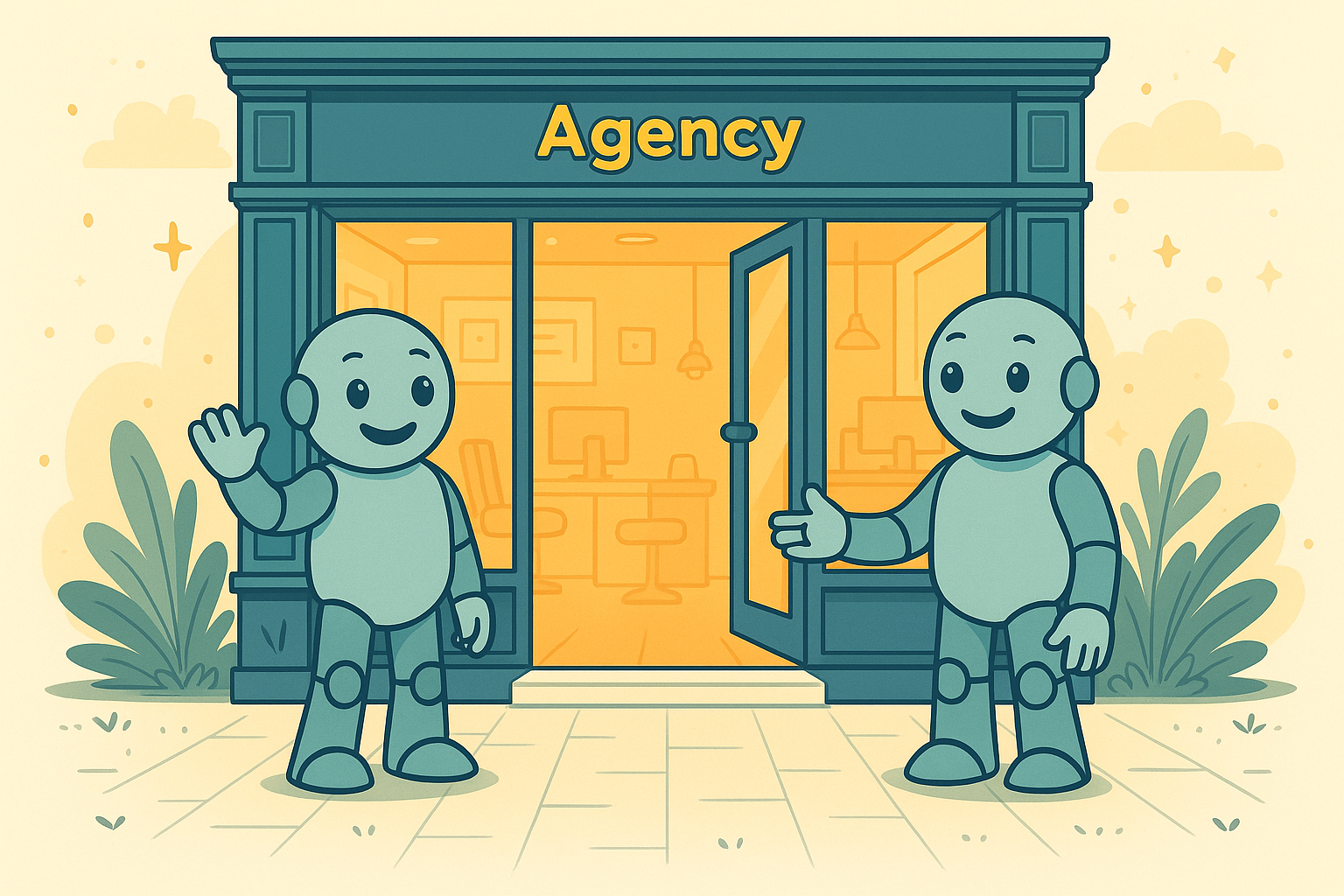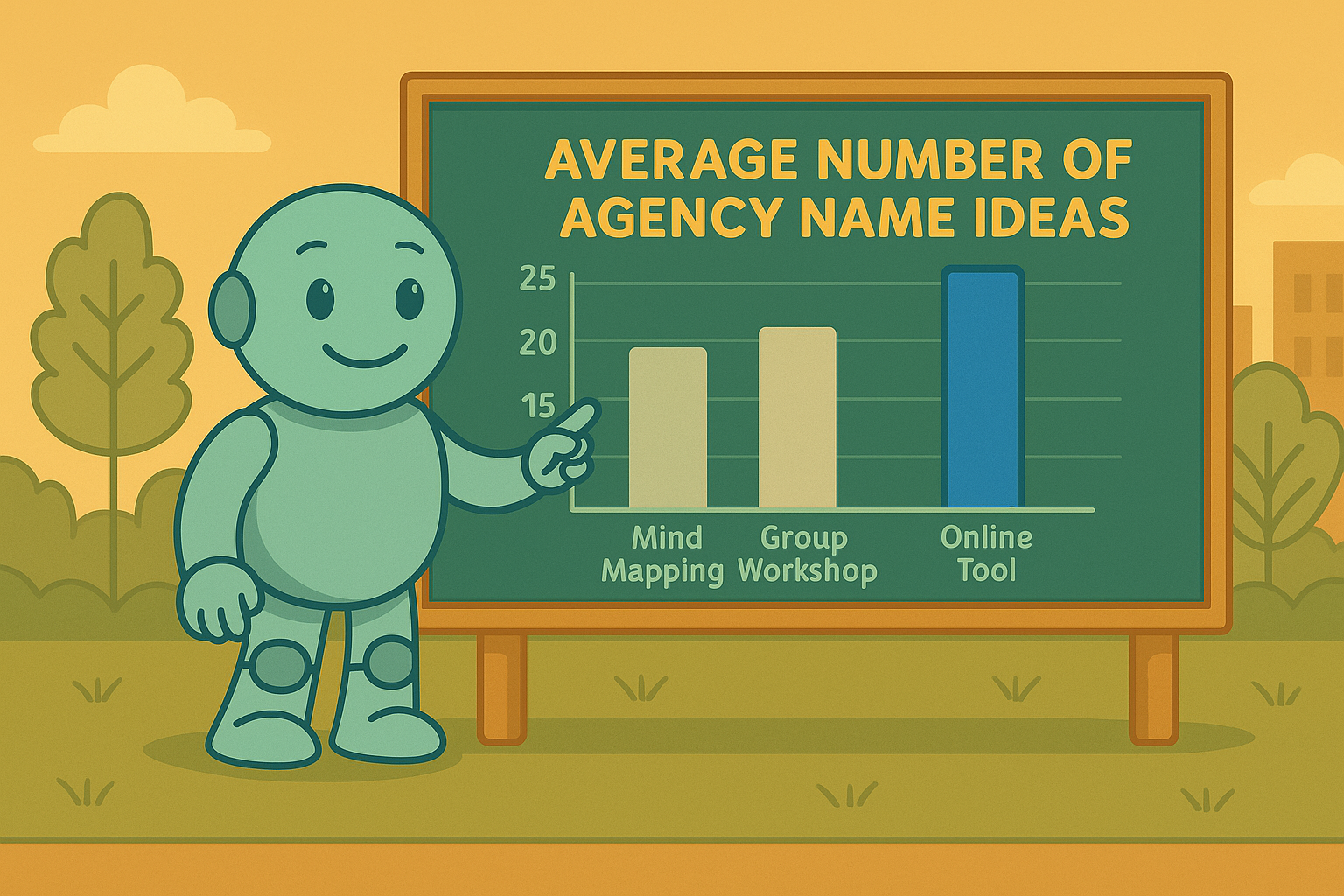Master the Art of Naming a Marketing Agency
Why Naming Your Marketing Agency Feels Nearly Impossible

Naming your marketing agency is more than just selecting a name; it's about building the core of your brand identity. This single decision carries significant weight, shaping how potential clients perceive your expertise, creativity, and overall value. This pressure makes the process challenging and can often feel overwhelming, even for experienced marketers. This feeling is common; many agency founders face the same dilemma.
The Weight of First Impressions
The difficulty comes from the need to capture your agency's entire essence in a single, memorable phrase. Your name is the first interaction with clients, setting the stage for future relationships. It needs to communicate professionalism, innovation, and a unique selling proposition all at once. The name must also resonate with your target audience, grabbing their attention and creating a connection. A poorly chosen name can confuse potential clients, misrepresent your services, and fail to make a lasting impact.
Navigating the Crowded Marketplace
The increasingly saturated market adds another layer of complexity. Thousands of marketing agencies are vying for attention, making differentiation essential. Your name needs to stand out and position your agency as unique. A generic name like "ABC Marketing" might disappear in the crowd, while a more distinct name like "BrandSpark Collective" can pique interest. This constant comparison and the drive to stand out add to the naming pressure.
The Importance of a Strong Name
Naming a marketing agency is often considered more difficult than other branding activities. In fact, 25% of small companies rank naming as the most important element when marketing a new brand. Only 12.8% of large companies share this view. This difference highlights how founders and smaller teams see their agency name as the key to establishing their market identity and making a strong first impression. Even among Chief Marketing Officers (CMOs), 18.7% consider naming the most crucial element for successfully introducing a new brand – the highest percentage for any marketing category. You can find more detailed statistics here: Branding Statistics.
Overcoming Naming Paralysis
Despite these challenges, many agencies have successfully navigated the naming process. They overcame initial hurdles by using strategic frameworks, testing their ideas, and ultimately choosing a name that reflects their vision. The following sections will explore these strategies, offering a practical guide to creating a name that not only resonates with clients but also helps your agency thrive.
The Frameworks Behind Unforgettable Agency Names

The chart above illustrates the average number of name ideas generated using various brainstorming techniques. Online tools clearly generate the highest average number of ideas (25), surpassing both mind mapping (20) and group workshops (15). This data highlights the efficiency of online tools for quickly generating a substantial list of potential names for your marketing agency. For further insights, explore this resource: How to master business name generators.
To help guide your naming process, let’s delve into a few key naming frameworks.
Founder-Based Naming
This approach, common among smaller agencies, leverages the founder's existing reputation and personal brand. It fosters immediate trust and connection, especially if the founder already has a strong industry presence. However, this method can pose scalability challenges should the founder decide to take a less active role or if the agency expands beyond the founder's area of expertise.
Descriptive Naming
Descriptive naming clearly articulates the agency's specialization. Examples include "Content Mastery Marketing" or "Social Spark Solutions". This direct approach allows potential clients to quickly understand the agency's services, instantly communicating value and attracting niche clients. The downside is reduced flexibility if the agency later decides to broaden its service offerings.
Abstract Naming
Abstract names evoke a feeling or concept, rather than explicitly stating services. Consider names like "BrandSpark" or "InnovateAegis". This approach provides greater creative freedom and generates intrigue, potentially attracting clients who appreciate originality. The trade-off is that abstract names often require more effort to build brand recognition and clearly communicate the agency’s services.
Compound Naming
Compound naming combines words or word fragments to form a unique and memorable name. This method blends the creativity of abstract naming with the clarity of descriptive naming. For example, "PixelPerch" combines "pixel," related to digital marketing, with "perch," suggesting a strategic viewpoint. This creates an evocative name that can be both memorable and relevant, though it requires careful crafting to avoid sounding contrived.
To help you compare and contrast these naming approaches, we’ve compiled the following table:
Marketing Agency Naming Approaches Comparison
This table compares different agency naming strategies with their advantages, potential drawbacks, and examples of successful agencies using each approach.
| Naming Approach | Advantages | Potential Drawbacks | Notable Examples |
|---|---|---|---|
| Founder-Based | Builds on established reputation, creates trust | Limits scalability, ties agency to individual | Smaller, founder-led agencies |
| Descriptive | Clearly communicates services, attracts niche clients | Less flexible for future expansion | Content Mastery Marketing (hypothetical), Social Spark Solutions (hypothetical) |
| Abstract | Creative freedom, generates intrigue | Requires more effort for brand recognition | BrandSpark (hypothetical), InnovateAegis (hypothetical) |
| Compound | Memorable and descriptive, blends creativity and clarity | Can sound forced if not well-crafted | PixelPerch (hypothetical) |
As this table shows, each naming framework has its own set of pros and cons. Choosing the right approach requires carefully considering your agency's specific needs and goals.
Aligning Frameworks With Business Models
Selecting the right framework depends heavily on your business model and target audience. A founder-based approach might suit a boutique agency focused on personal relationships. For a large, full-service agency, a more abstract or compound name could be more appropriate. The ultimate goal is to choose a framework that reinforces your agency’s positioning, reflects its values, and resonates with your ideal clients. This careful consideration will ensure your chosen name supports, rather than hinders, your growth as you expand and evolve your services.
Digital-First Naming: Beyond Basic Domain Availability
A marketing agency's name needs to resonate across the digital landscape. This online presence significantly impacts how we approach naming. Checking for domain availability is no longer sufficient. Several crucial digital factors can impact a name's success, often overlooked until too late. Agencies must adapt their naming strategies to succeed online.
Social Handle Consistency
Matching social media handles are essential for a cohesive brand. Inconsistency confuses potential clients. Imagine searching for "BrandSpark Marketing" on Twitter and finding a completely different handle. This disconnect can erode trust and harm your brand. Verifying handle availability across major platforms is a non-negotiable step.
Voice Search Optimization
With the increasing use of voice assistants, a name's sound is as important as its appearance. Consider how easily your potential name is understood and pronounced aloud. A name with complex spelling or unusual punctuation can be misinterpreted by voice search, leading to missed discovery opportunities.
Digital Distinction
The online world is saturated. The growth of digital marketing has changed how agencies are named, emphasizing distinction and memorability. In the 1990s and 2000s, digital advancements popularized short, unique, and memorable names for better search engine optimization (SEO) and online usability—think Google, eBay, or Netflix. Today, over 10,000 branding and positioning agencies exist globally, increasing competition. Learn more: Branding Stats. Your name must stand out in search results and be memorable in the constant flow of online information.
Cross-Platform Harmony
Your agency name should work seamlessly across websites, social media, email signatures, and online advertising. Consistent branding builds recognition and reinforces professionalism. Your agency name is your digital fingerprint, leaving a consistent impression. Also, consider its visual impact on different screen sizes and devices.
Avoiding Digital Pitfalls
Some naming conventions that work well in print create online issues. Using special characters or ampersands can complicate search engine indexing and social media tagging, limiting online visibility and reach. Further reading: How to master looking beyond the obvious. Evaluating potential names against these digital criteria avoids costly rebranding later, ensuring your name works effectively both online and offline.
Testing Agency Names That Actually Resonate
After brainstorming and shortlisting potential names for your marketing agency, testing is crucial. Relying solely on intuition can be risky. This section explores practical methods for validating your chosen names before committing. These techniques go beyond simple domain checks and delve into how your target audience perceives your potential brand identity.
Client Perception Testing
Gathering feedback directly from your target audience is invaluable. Consider using surveys, focus groups, or even informal interviews to gauge reactions to your shortlisted names. Ask open-ended questions to understand the emotions, associations, and overall impressions evoked. This qualitative data provides rich insights into how your name resonates with potential clients. For example, a name meant to convey innovation might be perceived as confusing or inaccessible to a specific target market.
Linguistic Analysis and International Considerations
If you're targeting international markets, linguistic analysis is critical. Ensure your name translates well and doesn't have negative connotations in other languages. This avoids embarrassing cultural misunderstandings and safeguards your brand reputation globally. A seemingly harmless name in English might have an unintended and unfavorable meaning elsewhere.
Evaluating Memorability and Pronunciation
A memorable name is essential for brand recognition. Test how easily your names are recalled after a short exposure. Also, assess pronunciation clarity. A name that's difficult to pronounce can hinder word-of-mouth marketing and brand recall. Consider simple pronunciation tests with a diverse group to identify potential issues.
Quantitative vs. Qualitative Feedback
Both quantitative and qualitative feedback are vital. Surveys provide numerical data on name preference and memorability, while qualitative feedback through interviews or focus groups offers deeper insights into the why behind those preferences. Understanding both the what and the why empowers informed decisions. This balance prevents over-reliance on either statistical significance or anecdotal evidence.
Interpreting Conflicting Responses and Avoiding Analysis Paralysis
Receiving conflicting feedback is normal. The key is identifying patterns and underlying themes. Don't get stuck on individual opinions. Focus on the overall sentiment and alignment with your brand identity. Also, avoid overthinking. While thorough testing is crucial, analysis paralysis can hinder progress. Set clear testing parameters and timelines. The naming process balances diligent research and decisive action. Interestingly, 22.7% of marketers report naming is the most difficult aspect of launching a new brand, highlighting the pressure to balance creativity with memorability and clarity. Simultaneously, only 8.1% of CMOs believe a new brand name must be a real word, allowing for unique and inventive options. Explore this topic further: Find more detailed statistics here.
By implementing these testing methods, you can confidently select a name that resonates with your target audience, supports your brand identity, and positions your marketing agency for success. This meticulous approach ensures your agency's name reflects your vision and resonates effectively with your ideal clients.
Building a Visual Identity That Amplifies Your Name

Your marketing agency's name is fundamental to your brand. However, it's the visual identity that truly brings it to life. This section explores how to develop visual elements that complement and amplify your chosen name, creating a cohesive and memorable brand experience. Think of your name as the foundation, and your visual identity as the architecture that makes it stand out.
Typography: Setting the Tone
The typeface you select is the visual voice of your agency's name. A bold, modern font can project confidence and innovation. A classic serif font, on the other hand, can communicate established expertise and tradition.
Consider the specialization of your agency. A firm focused on cutting-edge digital campaigns might choose a sleek sans-serif font. An agency concentrating on traditional public relations could opt for a more elegant, timeless typeface. The typography should reflect your agency's personality and resonate with your target audience.
Color Psychology: Evoking Emotion
Color significantly influences brand perception. Bright, vibrant colors can convey energy and creativity. Muted palettes can communicate professionalism and stability.
A marketing agency targeting a younger demographic might select a vibrant color scheme. A B2B agency focused on corporate clients might choose a more subdued palette. The colors you select should align with the message your agency name conveys.
Logo Design: The Visual Anchor
Your logo is the visual anchor of your brand, often the first visual element clients associate with your agency. A strong logo visually represents your name and core values, creating a lasting impression.
This could be a simple wordmark, featuring your agency name in a custom typeface. Alternatively, a more complex emblem incorporating symbolic imagery could be used. The key is to create a logo that’s visually appealing and representative of your brand’s personality. The logo should also be scalable and readily recognizable across various platforms.
Briefing Your Designers: Name-Driven Creative Direction
When collaborating with designers, provide a clear brief linking your agency's name to your desired visual identity. Share the rationale behind your name, highlighting key personality traits and target audience insights. This helps designers create visuals that truly capture your brand essence.
For instance, if your agency name is "InnovateAegis," emphasizing "innovation" and "protection" will guide the designer toward relevant visuals. This ensures your visual identity is not only aesthetically pleasing but also strategically aligned with your brand message.
Data reveals that only 43% of consumers recall a brand's name, while 78% remember its primary colors. This highlights the importance of a visually cohesive identity. Many agencies use data analytics and even crowdsourcing to test and refine their branding. Discover more insights about branding statistics here: Branding Stats.
Evaluating Concepts: Aligning With Your Name
When reviewing design concepts, assess how effectively they reflect the spirit of your name. Does the visual identity strengthen and complement your name, or does it clash with its intended message?
This careful evaluation ensures that your name and visuals work harmoniously to create a unified brand experience. A cohesive brand identity builds recognition, fosters trust, and differentiates you in a competitive market. Aligning your visuals with your name creates a powerful brand presence.
Legal Protection: Safeguarding Your Agency Name
Investing time and effort in a perfect marketing agency name is a crucial first step. However, ensuring its legal soundness is equally important. This section outlines actionable steps to navigate the legal landscape and protect your agency's name, preventing costly rebranding efforts down the line.
Trademark Searches: Your First Line of Defense
Before committing to a name, a preliminary trademark search is essential. This involves searching databases like the United States Patent and Trademark Office (USPTO) for similar registered trademarks. Identifying potential conflicts early can save significant time and resources later. For further guidance, explore resources like How to master verifying the availability of company names.
Understanding Trademark Protection Levels
Trademark protection comes in different forms. A registered trademark provides nationwide protection and exclusive rights to use the mark for specific services. Even without federal registration, common law trademark rights can offer some protection within a specific geographic area. Understanding these distinctions helps determine the best strategy for your agency.
Navigating Jurisdictional Considerations
Trademark protection is territorial. National or international operations require considering trademark registration in all relevant jurisdictions. A U.S. trademark doesn't automatically grant protection in other regions like the European Union. Globalization adds complexity, with smaller companies often facing more significant challenges. Statistics show 71.2% of small businesses find creating new brand names harder compared to larger companies with more validation resources. More insights on branding challenges can be found in resources like Branding Statistics.
Documenting Your Naming Process
Maintaining comprehensive records of the naming process, from brainstorming sessions to trademark searches and client feedback, is critical. This documentation validates your legitimate use of the name and strengthens your position in potential disputes. Meticulous record-keeping can prove invaluable should legal issues arise.
When to Involve Legal Professionals
While initial searches can be conducted independently, consulting a trademark attorney is crucial before finalizing your name. An attorney provides expert advice on trademark registration, potential conflicts, and enforcement. This expertise ensures your agency's name is legally sound.
Establishing Legitimate Use in Commerce
Actively using your agency name in business operations establishes "use in commerce," a key element for trademark protection. This includes using the name on marketing materials, invoices, and contracts. Consistent use builds a solid foundation for legal claims.
Maintaining Protection as Your Agency Grows
As your agency expands into new markets or services, revisiting your trademark strategy is essential. Filing for additional trademarks may be necessary to cover new offerings or geographic areas. Ongoing assessment ensures your legal protection aligns with your agency's growth.
To streamline the legal aspects of naming your agency, consider the following checklist:
Agency Naming Legal Checklist
Essential legal checks and procedures to complete before finalizing your marketing agency name
| Legal Consideration | Action Required | Resources/Tools | Timing |
|---|---|---|---|
| Trademark Availability | Conduct a comprehensive search for similar trademarks | USPTO, Trademarkia | Before finalizing the name |
| Jurisdiction | Determine the geographic scope of your trademark protection | Legal counsel | Before launching the business |
| Common Law Rights | Assess existing common law rights based on usage | Legal counsel | Before official registration |
| Registration | File for trademark registration in relevant jurisdictions | USPTO, WIPO | After clearing initial searches |
| Documentation | Maintain detailed records of the naming process | Internal documentation system | Throughout the entire process |
| Legal Counsel | Consult with a trademark attorney for expert advice | Legal directories | Before and during the registration process |
This checklist helps ensure you've covered the critical legal bases, allowing you to focus on building your brand.
Finally, selecting and protecting your agency name is a vital process. By following these steps, you can confidently establish a strong and legally sound brand identity. For further assistance with naming and trademark protection, NameRobot offers helpful tools and resources, including name generators and trademark search functionality. Explore their guide on How to master naming with NameRobot.















